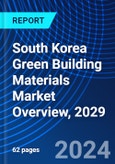10% Free customization
A number of variables and turning points have molded the South Korean market for green building materials. Early interest in sustainable building techniques was spurred by worries about resource depletion and air pollution. Green efforts were made possible by the government's establishment of the Ministry of Environment and the introduction of the Basic Environmental Policy Act. In order to promote the use of sustainable materials, the Green Standard for Energy and Environmental Design (G-SEED) system was introduced in 2002. Although the use of green construction materials in residential and commercial structures increased, cost was still a barrier.This report comes with 10% free customization, enabling you to add data that meets your specific business needs.
1h Free Analyst TimeSpeak directly to the analyst to clarify any post sales queries you may have.
The Green Construction Promotion Act seeks to advance environmentally friendly building methods and green building practices in South Korea. The act offers financial support, tax exemptions, subsidies, and incentives for eco-friendly technologies, renewable energy installations, and green building projects. In South Korea, the Energy Saving Design Standard (ESDS) establishes minimum energy performance standards for buildings. In order to lower energy consumption and greenhouse gas emissions, the ESDS requires the use of energy-efficient windows, insulation, building materials, lighting fixtures, and HVAC (heating, ventilation, and air conditioning) equipment. The selection and recommendation of Green Building Materials for construction projects is a critical function of green building consultants, architects, and design firms. In order to choose environmentally friendly materials that satisfy project specifications, sustainability objectives, and financial restraints, they frequently work in conjunction with manufacturers, suppliers, and contractors. Manufacturers, producers, and distributors of green building materials have the chance to exhibit their goods, connect with prospective customers, and present the newest developments in environmentally friendly building practices at trade shows, exhibits, and industry gatherings. These gatherings provide forums for information exchange, teamwork, and business growth in the green building sector.
According to the research report "South Korea Green Building Materials Market Overview, 2029,", the South Korea Green Building Materials Market is expected to reach market size more than USD 8 billion by 2029.In the upcoming years; South Korea is expected to be the Asia-Pacific region's primary source of revenue. Ceramic tile is frequently utilized in the construction of a variety of buildings, including homes, workplaces, and educational institutions. The growing inclination towards marble flooring along with the substitution of ceramic tiles for metal slabs, paints, and home décor items is anticipated to propel the market's expansion.
The construction industry is expected to gain from a number of reasons, including government attempts to spur infrastructure growth, rising per capita income, foreign investment, and population increase, which will in turn stimulate the size of the ceramic tiles market. Unglazed ceramic tiles with earthy tones and textured surfaces are in high demand due to the growing popularity of natural and minimalist interior design trends. High-quality tiles are an upgrade for homeowners who are modernizing their living spaces due to a strong DIY culture and increased disposable cash. Young designers and homeowners are drawn to the world of individualized and elaborate creations that digital printing opens up. Large format tiles minimize grout lines and produce smooth expanses that are perfect for the small size of many Korean homes. Online merchants and do-it-yourself stores provide as a conduit between customers and the industry, facilitating the easy procurement and installation of tiles.
Based on by Type the market can be categorized by Structural, Exterior, Interior, Others. In the South Korean market for green building materials, the structural segment is the market leader, while the exterior segment is becoming more significant. South Korea has a wide range of climates, including intense summer heat, chilly winters, and abundant rainfall. The materials used on the outside of buildings are essential for shielding structures from these factors. Green exterior materials improve building performance and energy efficiency by providing increased weather resistance, durability, and thermal insulation. The urban heat island effect, which causes metropolitan regions to get hotter than surrounding rural areas, is a problem for South Korean cities.
Based on By End Users the market can be categorized by Residential, Non Residential. In the South Korean green building materials industry, the residential segment is leading the way, but the non-residential green building materials segment is also growing significantly. Construction of commercial and institutional structures, such as office buildings, shopping malls, government buildings, healthcare facilities, and educational facilities, is expanding significantly throughout South Korea. There is an increasing need for green building materials that improve non-residential buildings' energy efficiency, environmental performance, and occupant comfort as developers and owners look to set their properties apart and achieve sustainability goals.
Based on by Application the market can be categorized by Roofing, Insulation, Framing, Flooring, Interior, and Other Applications. While insulation is also preferred, the roofing segment is one of the most common choices. Building homes that are energy-efficient requires insulation of the foundation, walls, attic, and roof. See-through windows, envelopes, and skylights are insulated to a great extent to minimize heat gain or loss, which in turn lessens heat transmission and vapor condensation. This is because glass is an inefficient insulator. Thus, insulating materials shield the building from moisture, freezing, mold, and deformation brought on by corrosion during construction.
This product will be delivered within 2 business days.
Table of Contents
1. Executive Summary4. South Korea Macro Economic Indicators10. Strategic Recommendations11. Disclaimer
2. Market Structure
3. Research Methodology
5. Market Dynamics
6. South Korea Green Building Materials Market Overview
7. South Korea Green Building Materials Market Segmentations
8. South Korea Green Building Materials Market Opportunity Assessment
9. Competitive Landscape
List of Figures
List of Tables







